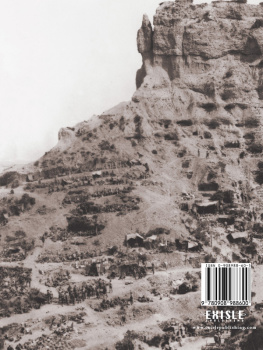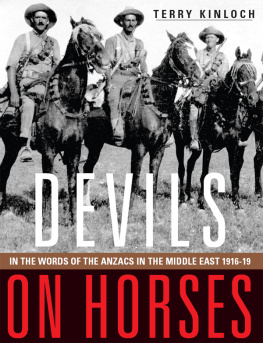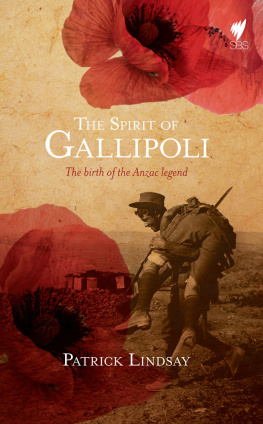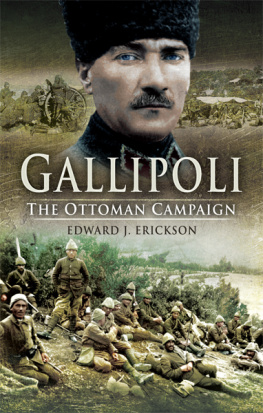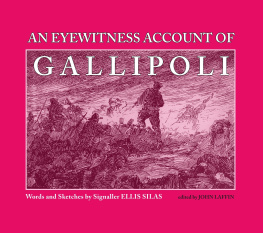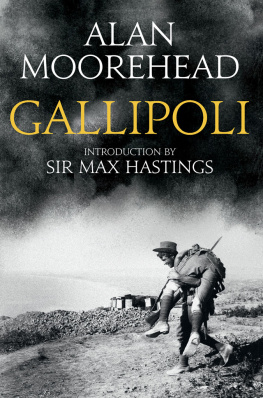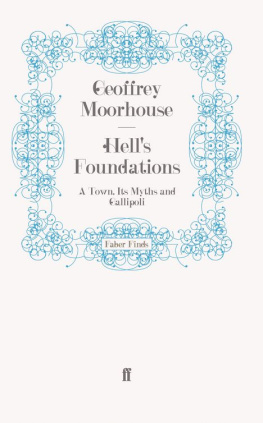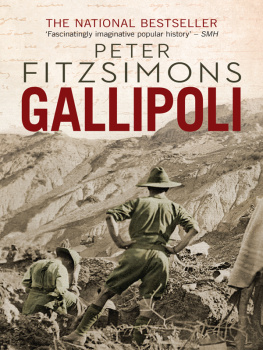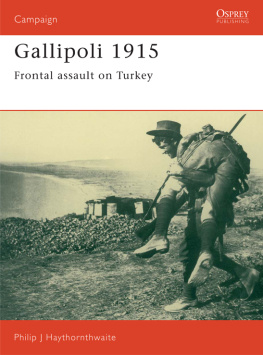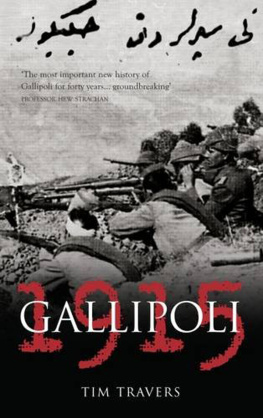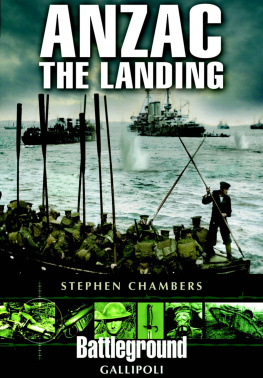The Gallipoli campaign of 1915 played an important part in making New Zealand the nation it is today. The heavy sacrifice of life affected the country for generations, and our annual remembrances on Anzac Day are still dominated by those battles ninety years ago. It is twenty years since the last book to tell the full story of Gallipoli from the New Zealand perspective was published. Now we have a new account that adds significantly to our understanding of what happened during those fateful months.
Terry Kinloch tells the story through the eyes of the men of the New Zealand Mounted Rifles Brigade, who fought at Gallipoli from May to December 1915. He has thoroughly researched their letters and diaries, cleverly weaving their eyewitness comments into his text. Much of this material has not been published before; the result is a book that reads with the immediacy of actually being there. The full story of the brigade is told: the mobilisation of the volunteers and their preparations in New Zealand, the long sea journey with thousands of horses, the frustrations of training in Egypt while the real war went on in Europe, the eventual arrival of the brigade at Gallipoli, the battles and skirmishes that were fought there, the disillusionment as the realities of trench warfare sank in, and finally their remarkable evacuation. The brigade emerged from the campaign battered and depleted, but with its reputation enhanced. More than 700 of the 4000 mounted riflemen who served on Gallipoli did not survive, and another 1200 were wounded.
Heavily illustrated with original photographs, Echoes of Gallipoli is the ideal book for anyone wanting to understand what it was like to be a young soldier in 1915, what really happened at Gallipoli and the impact these events had on one of our finest fighting formations.
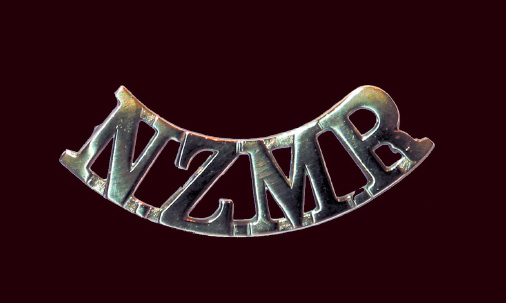
ECHOES OF
GALLIPOLI
IN THE WORDS OF NEW ZEALANDS MOUNTED RIFLEMEN
TERRY KINLOCH
Foreword by the Rt Hon. Helen Clark

Dedicated to
New Zealands mounted riflemen
Contents
Acknowledgements
I would like to thank the following people: Chris Pugsley, Glyn Harper and Ian McGibbon, ONZM, for their advice and guidance, and for reviewing the draft manuscript; Colonel Mark Wheeler and Lieutenant Colonel Paul van den Broek (New Zealand Army) for reviewing the draft manuscript; the late Bill Meldrum for his support and for granting me permission to quote from his fathers records; the Chief of Army, Major General Jerry Mateparae, ONZM, for funding the maps and the photographs; Ian Watt at Exisle Publishing for taking a chance with an unknown author; Douglas Thwaites of the Australian War Memorial, Blair Gatehouse of Oxford University Press (Australia) and Andrew Caldwell of New Zealand Geographic for permission to publish maps; Dolores Ho at the Kippenberger Military Archive, Army Memorial Museum in Waiouru; Bruce Ralston and Diane Gordon at the Auckland War Memorial Museum Library; Gillian Tasker at the Wanganui District Library; Jocelyn Chalmers at the Alexander Turnbull Library; Carolyn Carr and her patient staff at the Defence Library, Wellington; Ann Edmonds and Julie Molina at the Trentham Camp Library; Greg Bradley; Walter Guttery at Personnel Archives, Headquarters New Zealand Defence Force; the staff of the Commonwealth War Graves Commission, especially Alex Sutherland, Ilhan Bettemir and Maureen Annetts; and lastly, my wife Carol, for reviewing the manuscript, collating the casualty database, accompanying me to Gallipoli and to the Commonwealth War Graves Commission cemeteries in Egypt and Turkey, and for accepting the many long hours at the computer that this task has demanded of me. I would also like to thank everyone who granted me permission to publish photographs and excerpts from diaries, letters and interview transcripts. For those copyright holders I was unable to locate, I trust that the material quoted meets with your approval.

Foreword
The New Zealand Mounted Rifles Brigade
This book tells the story of the New Zealand Mounted Rifles Brigade and its service in the Gallipoli campaign. As we look back, almost 90 years later, we reflect on what was a terrible but hugely significant episode in our history. The service and the immense sacrifice of the brigade along with the rest of the New Zealanders in that campaign has developed a special meaning. It was at Gallipoli that we New Zealanders began to develop our own unique identity.
I visited Gallipoli in both 1995 and 2000 for significant anniversaries of the Anzac landings. I toured the battlefields and in 2000 saw the grave of my great-uncle, Frank Clark, a trooper in the New Zealand Mounted Rifles Brigade, who was killed at Hill 60 in August 1915.
My great-uncle and his colleagues came ashore into a war few of them could have ever imagined before they left New Zealand. One New Zealand soldier wounded at Chunuk Bair described it as hell. He said it was utterly lonely and hopeless. Bursting shells all around, confusion all around too. War at its worst! This was the everyday experience of ordinary soldiers at Gallipoli.
My great-uncle wrote home from Hill 60 on 21 August that: there are stray bullets flying everywhere and one stands a chance of stopping one at any time. Our sergeant was standing in our trench yesterday and he got one in the right breast. He wrote further: the big guns from land and sea make an awful row and this is accompanied always with machine guns and rifle fire. We can hear the shells screaming overhead and the shrapnel bursting all day long. He died seven days later.
Of 8556 New Zealand soldiers who served on the Gallipoli peninsula, 2721 died and 4752 were wounded. The suffering of their families was great too. For a small country, with a population in 1915 of only some one million people, this was a human tragedy on an unprecedented scale which affected almost every New Zealand family.
The men of the New Zealand Mounted Rifles Brigade played an important role and this book tells their tale. It will help to preserve their experiences for generations of future New Zealanders. Lest we forget.

Helen Clark
Prime Minister
Introduction
These New Zealanders and Australians and, best of all, the Australian Light
Horse and the New Zealand Mounted Rifles, and above all the last named, are
the flower of our troops or of any other troops in the world.
GENERAL SIR IAN HAMILTON
The magnificent brigade of New Zealand Mounted Rifles had been worked
until it was almost entirely consumed.
CHARLES BEAN

ON THE HOT AND sunny afternoon of Sunday 8 August 1915, 248 men belonging to the Auckland regiment of the New Zealand Mounted Rifles (NZMR) Brigade crept up Rhododendron Ridge and joined the survivors of the Wellington Infantry Battalion on Chunuk Bair, a hilltop on the Gallipoli peninsula in Turkey. On the way up the ridge they passed the scattered bodies of many dead and dying New Zealanders, victims of Turkish artillery and machine gun fire. The Aucklanders barely had time to clear the shallow trenches of the many dead and wounded Wellington infantrymen before they faced the first of many fierce Turkish bayonet attacks. For the rest of the day they were subjected to showers of hand grenades and relentless artillery, rifle and machine gun fire. They gave as good as they got, catching and throwing back live grenades (they had few of their own), shooting down charging Turks at ranges of a few metres and climbing out of their trenches to conduct their own desperate bayonet charges whenever the Turks got too close. When there were no grenades to throw back, they dug stones out of the trench wall with their bayonets and threw them at the Turks. What little water they had soon ran out, and the sun beat down on them mercilessly. Men were killed and wounded with every passing minute.
Next page
